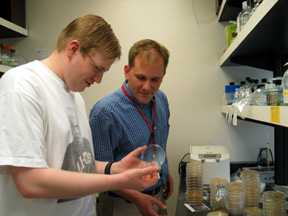 |
Graduate student Luke Handke, left, and Paul Fey, Ph.D., associate professor, examine the contents of several petri dishes in Dr. Fey’s lab. |
Handke’s findings are published in a feature article in the May issue of The Journal of Medical Microbiology. Handke published his article with other UNMC colleagues, including associate professors Paul Fey, Ph.D., and Mark Rupp, M.D.; and collaborators in Dublin, Ireland.
“The article focuses on a bacterium, Staphylococcus epidermidis, that usually lives harmlessly on everyone’s skin,” Handke said.
It’s when the bacteria adheres to an IV catheter or other prosthetic device, such as those used for hip replacements, that it can cause an infection, he said.
Handke and Dr. Fey, associate professor, internal medicine and infectious diseases, and pathology and microbiology, have spent the past four years researching the biology of S. epidermidis mediated infections.
“The way the staphlococci attach to the prosthetic device is by surrounding itself with a protective coating called a biofilm,” Handke said. “This biofilm protects the bacterium from being killed by the body’s immune system or antibiotics.”
In his first year of research with Dr. Fey, Handke noticed that individual cells within the population of bacteria did not produce biofilm. This phenomenon is termed phenotypic variation.
Dr. Fey said how and why S. epidermidis shuts off the genes that produce proteins, which synthesize biofilm, remains a mystery.
“We are looking at the regulation of the genes that make the biofilm,” Dr. Fey said. “We hope that studying the regulation of biofilm production will uncover new and novel ways to inhibit its production. It is anticipated that coating catheters or other biomaterials with biofilm inhibitors would be a novel treatment regimen.”
“This is a significant problem,” Dr. Fey said. “Physicians have a very difficult time treating this type of infection. In many cases, the prosthetic device has to be removed.” There are more than 250,000 catheter-related bloodstream infections each year in the United States, with a cost of approximately $25,000 each.
Ironically, S. epidermidis are good bacteria that actually help protect a person from other potentially harmful bacteria. “Since there are large numbers of S. epidermidis that colonize the skin, they out compete other bacteria, like Staphylococcus aureus, that might cause more serious infections,” Dr. Fey said.
Handke is currently writing three more in-depth research papers on the same topic, which he also hopes to publish.
As the first graduate student in the lab, Dr. Fey said Handke, along with internal medicine technologist Shawn Slater, laid the groundwork for the majority of the S. epidermidis research.
Handke interned with Dr. Fey as an undergraduate in 1999 and, after graduating in 2000 with a bachelor’s of science degree in biology from Kansas State University, returned to UNMC to begin his graduate studies. In addition to Handke, graduate students Kathie Rogers and Wendy Giles also work with Dr. Fey.